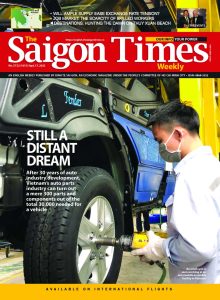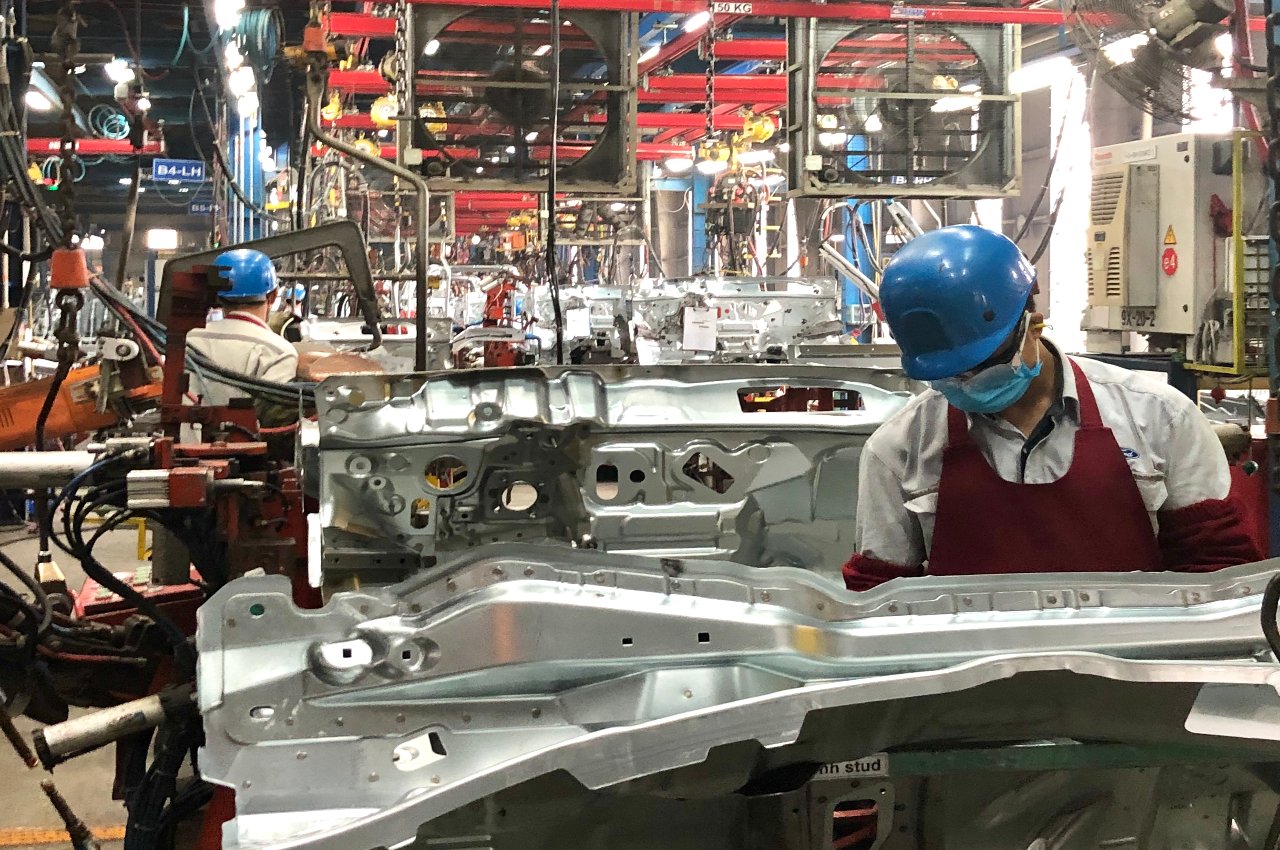After 30 years of auto industry development, Vietnam’s auto parts industry can turn out a mere 300 parts and components out of the total 30,000 needed for a vehicle
In early October, Vietnam will lift the regulations on the localization ratio in the automotive industry and the levels at which imported auto parts are knocked down. The regulations have long been relied on as a much-needed motivation for assemblers and makers to boost the ratio of local content and for the country as a whole to spur the development of the auto parts industry. In what direction the auto industry will be headed after the removal of the local auto content rules?
Modest results
During the two challenging years of the Covid-19 pandemic, Toyota Vietnam secured cooperation with 12 more suppliers, bringing the total to 46. Among these suppliers, just six are of Vietnam, said Hiroyuki Ueda, general director of Toyota Vietnam, during the signing ceremony in June of a memorandum of understanding with the Vietnam Industry Agency at the Ministry of Industry and Trade.
Toyota Vietnam has added 324 more locally-made parts to its autos, increasing the total number of made-in-Vietnam parts to 724. “We want to have more domestic suppliers and more than 200 local parts for our vehicles by the end of 2022,” noted Hiroyuki.
The number of Vietnamese businesses active in the auto parts industry remains small due to slow growth. Meanwhile, Thailand has over 700 Tier 1 suppliers, whereas Vietnam has less than 100. For Tier 2 and 3 suppliers, Thailand has 1,700 but there are a mere 150 in Vietnam, according to the Ministry of Industry and Trade.
Toyota Vietnam is one of the few automotive assembly joint ventures that have made significant effort to scale up the localization ratio of domestically assembled vehicles. However, what the company has achieved so far is like a drop in the ocean as a vehicle has an average of 30,000 parts.
According to the ministry, the auto parts industry has 350 businesses, with 80% of them foreign-invested and the remainder consisting of mainly small enterprises with limited financial resources for access to advanced technology. Moreover, the linkage between these suppliers is weak.
In particular, the ratio of local content in vehicles with up to nine seats remains lower than expected. The target for 2020 was 30-40%, 40-45% for 2025 and 50-55% for 2030. However, local content in made-in-Vietnam vehicles now accounts for a mere 7-10%. Thaco-assembled vehicles have 15-18% of local content, and it is 37% of Toyota’s Innova minivans. The result is far short of the goals and far behind regional countries, including Thailand, Indonesia and Malaysia.
In the eyes of experts, the country’s auto parts strategy does not include binding requirements for assemblers and joint ventures to boosting localization.
Auto companies have put the blame on the small size of the auto market, saying regulatory constraints have hampered the auto industry’s objective of raising the ratio of local content.
According to analysts, although the Government and provincial governments have tried to find ways to fuel industrial growth, there is still a long way to go before any given policy becomes more feasible, practical, and easy to implement.
Each automobile has roughly 30,000 parts and components, according to the Vietnam Automobile Manufacturers’ Association (VAMA), but up to 80% of them have to be imported. The remaining 20% are made in the country, mostly simple parts. As a result, auto manufacturing and assembly costs in the country are 10-20% higher than normal, making vehicles here in Vietnam around 20% more expensive than neighboring nations.
Local firms mainly make non-critical items, including windshield tape, energy consumption stickers, registration stickers, fuel stickers, fuel and water pipes, radiator covers, tubeless tires, wiring and fenders.
“Only a few firms invest in metal stamping lines, with a significant absence of essential components in the product catalog, including engines, transmissions, gearboxes, safety and electrical systems on vehicles,” according to VAMA.
More importantly, Vietnam mainly produces labor-intensive parts using primitive technology: seats, glasses, tires and wheels. Conversely, the domestic auto parts industry imports a majority of core technologies and value-added components, consisting of items for braking systems, clutches, gearboxes, and steering systems.
For example, the fuel tank cap costs US$1.5 in Thailand but suppliers in Vietnam charge from US$2.5 to US$3.8 each. Therefore, many automakers are more inclined to prefer importing parts over finding a domestic supplier.

Rescinding auto localization regulations
This year, the Ministry of Science and Technology issued Circular No. 11 eliminating requirements for localization of vehicle production. After more than 20 years, the local auto content requirements will be officially repealed as they are no longer suitable for the current state of the automotive industry.
The circular will come into effect from October 1, leading to the removal of Decision No. 28/2004, Decision No. 05/2005, and Circular 05/2012, among other relevant regulations.
The decision is deemed necessary to keep up with the current auto industry development trends and the requirements of Vietnam’s free trade agreements signed with other countries.
Moreover, the effort aims to address rising manufacturing demands in conformity with industrial regional, and global standards, ensuring the coherence of the legal system.
Vietnam still evaluates the ratio of local content based on clusters of locally made parts, whereas other ASEAN member nations rely on the total value of each item in order to qualify for tax incentives under the ASEAN Trade in Goods Agreement (ATIGA).
The ratification of trade regional and international free trade deals, including ATIGA, CPTPP, and EVFTA, allows Vietnam to abolish import tax discrimination against completely built-up (CBU) vehicles and sets of components. The Government should therefore demand that the relevant ministries and agencies modify the relevant regulations.
Will investors stay put if no benefits are offered?
The Ministry of Science and Technology once devised a framework for assessing the localization ratio based on the degree of fragmentation of imported auto parts as part of the Prime Minister’s “Strategy for the Development of Vietnam’s Automotive Industry to 2010 with a Vision to 2020.”
Auto firms have spent big on manufacturing processes, including welding machines, electro static power coating lines, and casting and stamping lines, as required by the fragmentation regulation on completely knocked-down (CKD) components.
It should be noted that domestic assemblers who import these components instead of investing in production lines face the same high taxes as CBU imports. Manufacturers have attempted to localize the production of many parts, such as body parts, exhaust pipes, seats, wiring and antennas.
As auto companies will no longer be obligated to comply with the CKD component requirements when Decision No. 5 is lifted, they will be able to modify their budget allocations for other objectives from October 1. Both newly-established and existing manufacturers may be less likely to embark on new vehicle model projects or unwilling to invest in domestic welding, electro static powder coating, stamping, and manufacturing lines.
Concerns would emerge as to how long the localization effort will last, and whether the move will threaten the sustainability and growth of Vietnam’s automotive industry and related industries.
Relaxing the regulations is in line with the current development and technological advancement of vehicle manufacturing at home and abroad. Given market dynamics, the automotive industry needs legal reforms and comprehensive strategies to attract investment and accelerate localization, according to experts.
The low localization ratio makes the local auto industry lag far behind other regional countries. Vietnam should build a mechanism for tracking vehicle localization ratios using international standards, boosting domestic production and setting the stage for the rise of export-oriented businesses.
Upgrading technology and raising the localization ratio will help producers optimize production, reduce costs and improve competitiveness.









